Kennington (UK Parliament constituency)
Kennington was a borough constituency centred on the Kennington district of South London. It returned one Member of Parliament (MP) to the House of Commons of the Parliament of the United Kingdom.
| Kennington | |
|---|---|
| Former Borough constituency for the House of Commons | |
| 1885–1950 | |
| Number of members | one |
| Replaced by | Vauxhall and Brixton |
| Created from | Lambeth |
The constituency was created for the 1885 general election, and abolished for the 1950 general election.
In 1918 Alice Theresa Lucas became the first woman to stand as a Conservative party candidate. She took 32.2% of the vote and came second to the Liberal candidate Henry Purchase. She would have been the first woman MP if she had been elected.[1]

Kennington in London 1885–1918
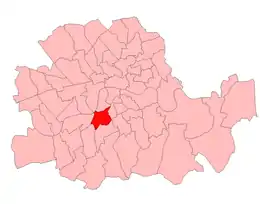
Kennington in London 1918–50
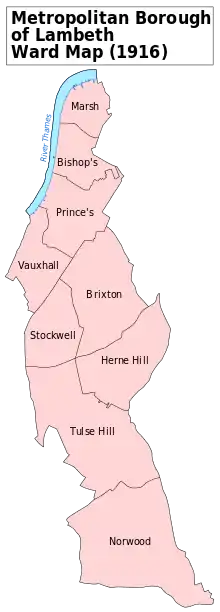
Members of Parliament
Election results
Elections in the 1940s
| Party | Candidate | Votes | % | ±% | |
|---|---|---|---|---|---|
| Labour | Charles Gibson | 12,910 | 70.2 | +10.1 | |
| Conservative | S.H. Stanley | 5,471 | 29.8 | -10.1 | |
| Majority | 7,439 | 40.4 | +20.2 | ||
| Turnout | 29,529 | 62.2 | +11.6 | ||
| Labour gain from Conservative | Swing | ||||
Elections in the 1930s
| Party | Candidate | Votes | % | ±% | |
|---|---|---|---|---|---|
| Labour | John Wilmot | 10,715 | 60.1 | +11.2 | |
| Conservative | A. Kennedy | 7,119 | 39.9 | -11.2 | |
| Majority | 3,596 | 20.2 | N/A | ||
| Turnout | 43,907 | 40.6 | -15.1 | ||
| Labour gain from Conservative | Swing | ||||
| Party | Candidate | Votes | % | ±% | |
|---|---|---|---|---|---|
| Conservative | George Harvey | 12,401 | 51.1 | -13.2 | |
| Labour | Leonard Matters | 11,856 | 48.9 | +13.2 | |
| Majority | 545 | 2.2 | -26.4 | ||
| Turnout | 43,583 | 55.7 | -5.6 | ||
| Conservative hold | Swing | ||||
| Party | Candidate | Votes | % | ±% | |
|---|---|---|---|---|---|
| Conservative | George Harvey | 18,371 | 64.3 | +20.0 | |
| Labour | Leonard Matters | 10,188 | 35.7 | -20.0 | |
| Majority | 8,183 | 28.6 | N/A | ||
| Turnout | 46,600 | 61.3 | +1.2 | ||
| Conservative gain from Labour | Swing | ||||
Elections in the 1920s
| Party | Candidate | Votes | % | ±% | |
|---|---|---|---|---|---|
| Labour | Leonard Matters | 15,477 | 55.7 | +12.0 | |
| Unionist | George Harvey | 12,328 | 44.3 | −12.0 | |
| Majority | 3,149 | 11.4 | N/A | ||
| Turnout | 27,805 | 60.1 | −10.2 | ||
| Registered electors | 46,290 | ||||
| Labour gain from Unionist | Swing | +12.0 | |||
| Party | Candidate | Votes | % | ±% | |
|---|---|---|---|---|---|
| Unionist | George Harvey | 14,898 | 56.3 | +19.5 | |
| Labour | Thomas Williams | 11,572 | 43.7 | +4.5 | |
| Majority | 3,326 | 12.6 | N/A | ||
| Turnout | 26,470 | 70.3 | +12.7 | ||
| Registered electors | 37,629 | ||||
| Unionist gain from Labour | Swing | +7.5 | |||

Jacobsen
| Party | Candidate | Votes | % | ±% | |
|---|---|---|---|---|---|
| Labour | Thomas Williams | 8,292 | 39.2 | +3.1 | |
| Unionist | Reginald Blair | 7,782 | 36.8 | −10.5 | |
| Liberal | Thomas Owen Jacobsen | 5,075 | 24.0 | +7.4 | |
| Majority | 510 | 2.4 | N/A | ||
| Turnout | 21,149 | 57.6 | −0.8 | ||
| Registered electors | 36,729 | ||||
| Labour gain from Unionist | Swing | +6.8 | |||

Gosling
| Party | Candidate | Votes | % | ±% | |
|---|---|---|---|---|---|
| Unionist | Francis Harrison | 10,081 | 47.3 | +15.1 | |
| Labour | Harry Gosling | 7,670 | 36.1 | +10.7 | |
| National Liberal | Henry Purchase | 3,522 | 16.6 | −25.8 | |
| Majority | 2,411 | 11.2 | N/A | ||
| Turnout | 21,273 | 58.4 | +28.7 | ||
| Registered electors | 36,451 | ||||
| Unionist gain from Liberal | Swing | +20.5 | |||
Elections in the 1910s
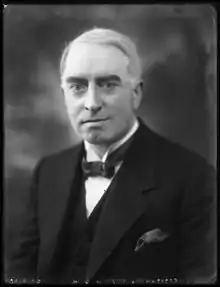
Purchase
| Party | Candidate | Votes | % | ±% | |
|---|---|---|---|---|---|
| C | Liberal | Henry Purchase | 4,705 | 42.4 | −5.2 |
| Unionist | Alice Lucas | 3,573 | 32.2 | −14.7 | |
| Labour | William Glennie | 2,817 | 25.4 | New | |
| Majority | 1,132 | 10.2 | +9.5 | ||
| Turnout | 11,095 | 29.7 | −44.5 | ||
| Registered electors | 37,322 | ||||
| Liberal hold | Swing | +4.8 | |||
| C indicates candidate endorsed by the coalition government. | |||||
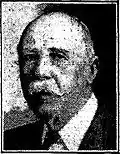
Collins
| Party | Candidate | Votes | % | ±% | |
|---|---|---|---|---|---|
| Liberal | Stephen Collins | 3,565 | 47.6 | −4.7 | |
| Conservative | Francis Lucas | 3,510 | 46.9 | −0.8 | |
| Independent Labour | Victor Grayson | 408 | 5.5 | New | |
| Majority | 55 | 0.7 | −3.9 | ||
| Turnout | 7,483 | 74.2 | −6.2 | ||
| Registered electors | 10,088 | ||||
| Liberal hold | Swing | −2.0 | |||
| Party | Candidate | Votes | % | ±% | |
|---|---|---|---|---|---|
| Liberal | Stephen Collins | 4,246 | 52.3 | −8.0 | |
| Conservative | Francis Lucas | 3,865 | 47.7 | +8.0 | |
| Majority | 381 | 4.6 | −16.0 | ||
| Turnout | 8,111 | 80.4 | +6.3 | ||
| Registered electors | 10,088 | ||||
| Liberal hold | Swing | -8.0 | |||
Elections in the 1900s
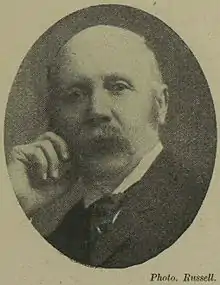
Collins
| Party | Candidate | Votes | % | ±% | |
|---|---|---|---|---|---|
| Liberal | Stephen Collins | 4,639 | 60.3 | +24.8 | |
| Conservative | Frederick Cook | 3,054 | 39.7 | −24.8 | |
| Majority | 1,585 | 20.6 | N/A | ||
| Turnout | 7,693 | 74.1 | +11.8 | ||
| Registered electors | 10,382 | ||||
| Liberal gain from Conservative | Swing | +24.8 | |||
| Party | Candidate | Votes | % | ±% | |
|---|---|---|---|---|---|
| Conservative | Frederick Cook | 4,195 | 64.5 | +12.7 | |
| Liberal | Walter Essex | 2,309 | 35.5 | −2.6 | |
| Majority | 1,886 | 29.0 | +15.3 | ||
| Turnout | 6,504 | 62.3 | −9.5 | ||
| Registered electors | 10,432 | ||||
| Conservative hold | Swing | +7.7 | |||
Elections in the 1890s
| Party | Candidate | Votes | % | ±% | |
|---|---|---|---|---|---|
| Conservative | Frederick Cook | 3,764 | 51.8 | +6.1 | |
| Liberal | Mark Beaufoy | 2,769 | 38.1 | −16.2 | |
| Independent Liberal | William Wightman | 730 | 10.1 | New | |
| Majority | 995 | 13.7 | N/A | ||
| Turnout | 7,263 | 71.8 | −4.3 | ||
| Registered electors | 10,117 | ||||
| Conservative gain from Liberal | Swing | +11.2 | |||
| Party | Candidate | Votes | % | ±% | |
|---|---|---|---|---|---|
| Liberal | Mark Beaufoy | 3,860 | 54.3 | +7.9 | |
| Conservative | Ferdinand Begg | 3,253 | 45.7 | −7.9 | |
| Majority | 607 | 8.6 | N/A | ||
| Turnout | 7,113 | 76.1 | +3.8 | ||
| Registered electors | 9,348 | ||||
| Liberal gain from Conservative | Swing | +7.9 | |||
Elections in the 1880s
| Party | Candidate | Votes | % | ±% | |
|---|---|---|---|---|---|
| Liberal | Mark Hanbury Beaufoy | 4,069 | 54.2 | +7.8 | |
| Conservative | Philip Beresford-Hope[3] | 3,439 | 45.8 | −7.8 | |
| Majority | 630 | 8.4 | N/A | ||
| Turnout | 7,508 | 84.2 | +11.9 | ||
| Registered electors | 8,920 | ||||
| Liberal gain from Conservative | Swing | +7.8 | |||
| Party | Candidate | Votes | % | ±% | |
|---|---|---|---|---|---|
| Conservative | Robert Gent-Davis | 3,222 | 53.6 | +1.0 | |
| Liberal | Mark Hanbury Beaufoy | 2,792 | 46.4 | −0.5 | |
| Majority | 430 | 7.2 | +1.5 | ||
| Turnout | 6,014 | 72.3 | −4.4 | ||
| Registered electors | 8,313 | ||||
| Conservative hold | Swing | +0.8 | |||
| Party | Candidate | Votes | % | ±% | |
|---|---|---|---|---|---|
| Conservative | Robert Gent-Davis | 3,351 | 52.6 | ||
| Liberal | John O'Connor Power | 2,991 | 46.9 | ||
| Social Democratic Federation | John Fielding | 32 | 0.5 | ||
| Majority | 360 | 5.7 | |||
| Turnout | 6,374 | 76.7 | |||
| Registered electors | 8,313 | ||||
| Conservative win (new seat) | |||||
References
- "Lucas [née Stern], Alice Theresa (1853–1924), parliamentary candidate | Oxford Dictionary of National Biography". www.oxforddnb.com. doi:10.1093/odnb/9780198614128.013.112246. Retrieved 1 April 2019.
- Craig, FWS, ed. (1974). British Parliamentary Election Results: 1885–1918. London: Macmillan Press. ISBN 9781349022984.
- "Kennington Election". Nottingham Evening Post. 16 March 1889. p. 4. Retrieved 2 December 2017 – via British Newspaper Archive.
- Craig, F. W. S. (1983) [1969]. British parliamentary election results 1918–1949 (3rd ed.). Chichester: Parliamentary Research Services. ISBN 0-900178-06-X.
- Leigh Rayment's Historical List of MPs – Constituencies beginning with "K" (part 1)
This article is issued from Wikipedia. The text is licensed under Creative Commons - Attribution - Sharealike. Additional terms may apply for the media files.